International Journal of Intelligent Systems and Applications @ijisa
Статьи журнала - International Journal of Intelligent Systems and Applications
Все статьи: 1203
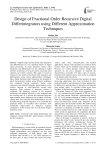
Статья научная
Digital integer and fractional order integrators and differentiators are very important blocks of digital signal processing. In many situations, integer order integrators and differentiators are not sufficient to model all kind of dynamics. For such systems, fractional order operators give better solution. This paper is based on design of a new family of fractional order integrators and differentiators using various approximation techniques. Here, digital fractional order integrators are designed by direct discretization method using different techniques like continued fraction expansion, Taylor series expansion, and rational Chebyshev approximation on the transfer function of Jain-Gupta-Jain second order integrator. Their response in frequency domain is compared. The frequency response of the proposed integrators with highest efficiency is also compared with the existing ones. It is proved that rational Chebyshev approximation based integrators have highest efficiency among them. The fractional order differentiators are also designed using proposed integrators. It is concluded that proposed family of fractional order operators show remarkable improvement in frequency response compared to all the existing ones over the entire Nyquist frequency range.
Бесплатно
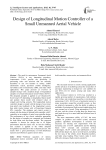
Design of Longitudinal Motion Controller of a Small Unmanned Aerial Vehicle
Статья научная
The need for autonomous Unmanned Aerial Vehicles (UAVs) is very interesting nowadays. Autonomous UAVs provide the possibility of performing tasks and missions that are currently hazardous or can cost humans or money, enable autonomous search, persistent combat intelligence, surveillance and reconnaissance (ISR), and many other applications. This paper presents an overview of autopilot design with a detailed design of longitudinal autopilot of a Small Unmanned Aerial Vehicle (SUAV). The designed autopilot is applied to an Ultrastick-25e fixed wing UAV depending on longitudinal linear model and analytic linear model with trimmed values of straight and leveling scenario. The longitudinal motion controller design is started with the design of most inner loop (pitch rate feedback) of the longitudinal system, then pitch tracker design with a Proportional Integral (PI)- controller. The guidance and control system is related with the design of altitude hold controller with P-controller as an example of outer loop controller design. The performance of two classic controller approaches for the design of autopilot are compared and evaluated for both linear and non-linear models. The proposed controller is chosen for design due to its higher performance than the classic one. At last the climbing turn scenario is applied to the whole autopilot (longitudinal and lateral) for the evaluation process. The results show a good performance in both disturbance rejection and robustness against sensors noise.
Бесплатно
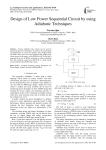
Design of Low Power Sequential Circuit by using Adiabatic Techniques
Статья научная
Various adiabatic logic circuits can be used for minimizing the power dissipation. To enhance the functionality and performance of circuit two adiabatic logic families PFAL and ECRL have been used and compared with CMOS logic circuit design. In this paper, A MASTER-SLAVE D flip-flop is proposed by the use of SPICE simulation on 90nm technology files. The simulation result shows that PFAL is a better energy saving techniques then ECRL logic circuit.
Бесплатно
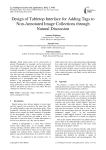
Статья научная
Many media forms can be stored easily at present. Photographs, for example, can be easily stored even though most of them have not been edited. This means they will gradually lose their value and become essentially unusable. To make better use of photographs, we tried to make use of information provided by viewers who had seen and commented on them. We felt that analyzing this information would enable us to make maximum use of photographic data. To do this, we defined a ''tag propagation'' model and relationships between photos. We also proposed a system that uses image processing to analyze viewers' handling of photos and how the photos are relevant to each other. We then validated our model by using it.
Бесплатно
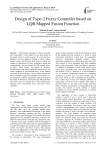
Design of Type-2 Fuzzy Controller based on LQR Mapped Fusion Function
Статья научная
“Rule number explosion” in fuzzy controller and “uncertainty” in the model are two main issues in the design of fuzzy control systems. To overcome these problems, we have applied a method in which a linear sensory fusion function has been used to reduce the number of dimensions of fuzzy controller’s inputs and simultaneously use the features of LQR control. Since, in type-2 fuzzy control, the degree of fuzziness increased and it can better handle the uncertainty in the model compared to conventional fuzzy, so the method of sensory fusion with type-2 fuzzy control scheme has been combined to make the controller more robust w.r.t. the parameter variation, perturbance and uncertainty in the model. Performance criteria like IAE, ISE and ITAE have been used to compare the control performance obtained from conventional fuzzy and type-2 fuzzy controller.
Бесплатно
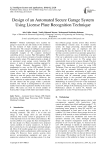
Design of an Automated Secure Garage System Using License Plate Recognition Technique
Статья научная
Modern technologies have reached our garage to secure the cars and entrance to the residences for the demand of high security and automated infrastructure. The concept of intelligent secure garage systems in modern transport management system is a remarkable example of the computer interfaced controlling devices. License Plate Recognition (LPR) process is one of the key elements of modern intelligent garage security setups. This paper presents a design of an automated secure garage system featuring LPR process. A study of templates matching approach by using Optical Character Recognition (OCR) is implemented to carry out the LPR method. We also developed a prototype design of the secured garage system to verify the application for local use. The system allows only a predefined enlisted cars or vehicles to enter the garage while blocking the others along with a central-alarm feature. Moreover, the system maintains an update database of the cars that has left and entered into the garage within a particular duration. The vehicle is distinguished by the system mainly based on their registration number in the license plates. The tactics are tried on several samples of license plate’s image in both indoor and outdoor setting.
Бесплатно
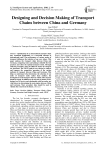
Designing and Decision Making of Transport Chains between China and Germany
Статья научная
Optimization of an international transport chain may contribute significantly to a successful outcome in international trade. The performance of various modes of transport influences the selection of one over others. This paper analyses the transport chain between China and Germany, comparing routes and aiming to identify the best practices and chose the optimal transport mode. Through analysing secondary data, the different means of transport are presented. The SWOT analysis was selected to analyse and compare the competitive operation of the various methods of transport between China and Germany. This helps us understand what determines the selection of one mode of transport mode rather than another; the development of rail transport between China and Germany should be urged, in addition to the air and sea modes; Price, timing, level of service and relationship with forwarder are vital factors in determining the route option between China and Germany. More secondary data should be used to validate the research in the future.
Бесплатно

Detailed Study of Wine Dataset and its Optimization
Статья научная
The consumption of wine these days is becoming more common in social gatherings and to monitor the health of individuals it's very important to maintain the quality of the wine. For the assessment of wine quality many methods have been proposed. We have described a technique to pre-process the “Vinho Verde” wine dataset. The dataset consists of red and white wine samples. The wine dataset size has been reduced from a total of 13 attributes to 9 attributes without any loss of performance. This has been validated through various classification techniques like Random Forest Classifier, Decision tree Classifiers, K-Nearest Neighbor Classifier and Artificial Neural Network Classifier. These classifiers have been compared based on two performance metrics of accuracy and RMSE values. Among the three classifiers Random Forest tends to outperform the other two classifiers in various measures for predicting the quality of the wine.
Бесплатно
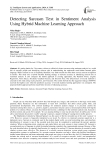
Detecting Sarcasm Text in Sentiment Analysis Using Hybrid Machine Learning Approach
Статья научная
It's getting harder for 21st-century citizens to effectively detect sarcasm using sentiment analysis in a world full of sarcastic people and identifying sarcasm aids in understanding the unpleasant truth hidden beneath polite language. While sarcasm in text is frequently identified, very little research has been done on text sarcasm recognition in memes. This study uses a hybrid machine learning strategy to increase accuracy in identifying sarcasm text in sentiment analysis. It also compares the hybrid approach to existing approaches, like Random Forest, Logistic Regression, Naive Bayes, Stochastic Gradient Descent, and Decision Tree. The effectiveness of several methods is assessed in this study using recall, precision, and f-measure. The results showed that the suggested strategy (0.8004%) received the highest score when the prediction accuracy of several machine learning approaches was compared. The proposed hybrid approach performs much better in terms of enhancing accuracy.
Бесплатно
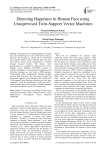
Detecting happiness in human face using unsupervised twin-support vector machines
Статья научная
This paper aims to finding happiness in human face with minimal feature vectors. In this system, the face detection and tracking are carried out by Constrained Local Model (CLM). Using CLM grid node, the entire and minimal feature vector displacement is obtained through extracted features. The feature vector displacements are computed in multi-classes of Twin- Support Vector Machines (TWSVM) classifier to evaluate the happiness. In training and testing phases, the following databases are used such as MMI database, Cohn-Kanade (CK), Extended-CK, Mahnob-Laughter and also Real Time data. Also, this paper compares the Supervised Support Vector Machines and Unsupervised Twin Support Vector Machines classifier with cross data-validation. Using the normalization of Min-max and Z-norm technique, the overall accuracy of finding happiness are computed as 86.29% and 83.79% respectively.
Бесплатно
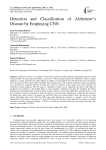
Detection and Classification of Alzheimer’s Disease by Employing CNN
Статья научная
Alzheimer’s illness is an ailment of mind which results in mental confusion, forgetfulness and many other mental problems. It effects physical health of a person too. When treating a patient with Alzheimer's disease, a proper diagnosis is crucial, especially into earlier phases of condition as when patients are informed of the risk of the disease, they can take preventative steps before irreparable brain damage occurs. The majority of machine detection techniques are constrained by congenital (present at birth) data, however numerous recent studies have used computers for Alzheimer's disease diagnosis. The first stages of Alzheimer's disease can be diagnosed, but illness itself cannot be predicted since prediction is only helpful before it really manifests. Alzheimer’s has high risk symptoms that effects both physical and mental health of a patient. Risks include confusion, concentration difficulties and much more, so with such symptoms it becomes important to detect this disease at its early stages. Significance of detecting this disease is the patient gets a better chance of treatment and medication. Hence our research helps to detect the disease at its early stages. Particularly when used with brain MRI scans, deep learning has emerged as a popular tool for the early identification of AD. Here we are using a 12- layer CNN that has the layers four convolutional, two pooling, two flatten, one dense and three activation functions. As CNN is well-known for pattern detection and image processing, here, accuracy of our model is 97.80%.
Бесплатно
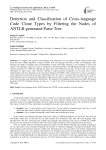
Статья научная
A complete and accurate cross-language clone detection tool can support software forking process that reuses the more reliable algorithms of legacy systems from one language code base to other. Cross-language clone detection also helps in building code recommendation system. This paper proposes a new technique to detect and classify cross-language clones of C and C++ programs by filtering the nodes of ANTLR-generated parse tree using a common grammar file, CPP14.g4. Parsing the input files using CPP14.g4 provides all the lexical and semantic information of input source code. Selective filtering of nodes performs serialization of two parse trees. Vector representation using term frequency inverse document frequency (TF-IDF) of the resultant tree is given as an input to cosine similarity to classify the clone types. Filtered parse tree of C and C++ increases the precision from 51% to 61%, and matching based on renaming the input/output expressions provides average precision of 91.97% and 95.37% for small scale and large scale repositories respectively. The proposed cross-language clone detection exhibits the highest precision of 95.37% in finding all types of clones (1, 2, 3 and 4) for 16,032 semantically similar clone pairs of C and CPP codes.
Бесплатно
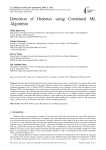
Detection of Diabetes using Combined ML Algorithm
Статья научная
Recently data clustering algorithm under machine learning are used in ‘real-life data’ to segregate them based on the outcome of a phenomenon. In this paper, diabetes is detected from pathological data of 768 patients using four clustering algorithms: Fuzzy C-Means (FCM), K-means clustering, Fuzzy Inference system (FIS) and Support Vector Machine (SVM). Our main objective is to make binary classification on the data table in a sense that presence or absence of diabetes of a patient. We combined the four machine learning algorithms based on entropy-based probability to enhance accuracy of detection. Before applying combining scheme, we reduce the size of variables applying multiple linear regression (MLR) on the table then logistic regression is again applied on the resultant data to keep the outlier within a narrow range. Finally, entropy based combining scheme with some modification is applied on the four ML algorithms and we got the accuracy of detection about 94% from the combining technique.
Бесплатно

Detection of Metamorphic Malware based on HMM: A Hierarchical Approach
Статья научная
Recent research have depicted that hidden Markov model (HMM) is a persuasive option for malware detection. However, some advanced metamorphic malware are able to overcome the traditional methods based on HMMs. This proposed approach provides a two-layer technique to overcome these challenges. Malware contain various sequences of opcodes some of which are more important and help detect the malware and the rest cause interference. The important sequences of opcodes are extracted by eliminating partial sequences due to the fact that partial sequences of opcodes have more similarities to benign files. In this method, the sliding window technique is used to extract the sequences. In this paper, HMMs are trained using the important sequences of opcodes that will lead to better results. In comparison to previous methods, the results demonstrate that the proposed method is more accurate in metamorphic malware detection and shows higher speed at classification.
Бесплатно
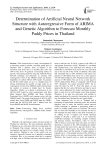
Статья научная
This research aims to study a development of a forecasting model to predict a monthly paddy price in Thailand with 2 datasets. Each of datasets is the univariate time series that is a monthly data, since Jan 1997 to Dec 2017. To generate a forecasting model, we present a forecasting model by using the Artificial Neural Network technique and determine its structure with Autoregressive form of the ARIMA model and Genetic Algorithm, it’s called AR-GA-ANN model. To generate the AR-GA-ANN model, we set 1 to 3 hidden layers for testing, determining the number of input nodes by an Autoregressive form of the ARIMA model and determine the number of neurons in hidden layer by Genetic Algorithm. Finally, we evaluate a performance of our AR-GA-ANN model by error measurement with Root Mean Squared Error (RMSE) and Mean Absolute Percentage Error (MAPE) and compare errors with the ARIMA model. The result found that all of AR-GA-ANN models have lower RMSE and MAPE than the ARIMA model and the AR-GA-ANN with 1 hidden layer has lowest RMSE and MAPE in both datasets.
Бесплатно
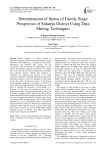
Determination of status of family stage prosperous of Sidareja District using data mining techniques
Статья научная
Family welfare is a family formed in legitimate marriage, spiritual needs and material worthy, devoted to God YME, have a harmonious relationship, harmonious and balanced with society and the environment. The government has implemented various family development programs prosperous. To support this, every year the government implements the family data collection process. Family data collection is considered an important step because it has many functions, primarily to understand the target group and to determine solutions to solve the problems of each target group. The search or discovery process of information and knowledge contained in the number of data can be done with data mining technology. Data mining is a term used to describe the discovery of knowledge in a database. In this case data mining can be used to determine the status of the prosperous family stage. The K-Nearest Neighbor (KNN) method, the Naive Bayes method and the Principal Component Analysis (PCA) are used for the proper classification of status stages. Based on the test results, the performance test of classification algorithm for case of determining status of prosperous family of Sidareja District for Naïve Bayes method using confusion matrix obtained 98.12% accuracy after added PCA feature selection to 97.73% while KNN method obtained accuracy of 98.86%, then after added PCA feature selection increased to 98.96%.
Бесплатно
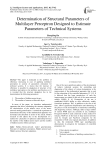
Статья научная
The paper is dedicated to the problem of efficiency increasing in case of applying multilayer perceptron in context of parameters estimation for technical systems. It is shown that the increase of efficiency is possible by adaptation of structure of the multilayer perceptron to the problem specification set. It is revealed that the structure adaptation lies in the determination the following parameters: 1. The number of hidden neuron layers; 2. The number of neurons within each layer. In terms of the paper, we introduce mathematical apparatus that allows conducting the structure adaptation for minimization of the relative error of the neuro-network model generalization. A numerical experiment to demonstrate efficiency of the mathematical apparatus was developed and described in terms of the article. Further research in this sphere lies in the development of a method for calculation of optimum relationship between the number of the hidden neuron layers and the number of hidden neurons within each layer.
Бесплатно
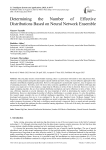
Determining the Number of Effective Distributions Based on Neural Network Ensemble
Статья научная
Since big data streams contain hidden meanings, there is a permanent motivation to store and process them. However, storing and processing this data requires special methods and tools. Today, the most effective approach for this situation is distributed computing mechanisms. However, this approach is economically expensive, since it requires a lot of computing resources. Therefore, users who do not have economic capabilities strive to solve problems with large data streams on a single server. In this situation, a sharp drop in efficiency in terms of time is observed. However, even for a single computing machine, the use of an internal distribution mechanism can lead to efficiency in terms of time. In this case, efficiency depends on several indicators, the most important of which is determining the number of effective distributions. However, determining the number of effective distributions is a complex process. To solve this problem, this research paper considers the use of artificial intelligence algorithms. First of all, the research methodology is developed and processes that are in it are explained. In the next step, Random Forest, XGBoost, Support Vector Regression, and Multiple Linear Regression algorithms are tested to determine the number of effective distributions. In order to improve the accuracy of the study, a multilayer neural network is improved, that is, a neural network ensemble method is developed that combines the above machine learning algorithms. At the end of the study, the research results are presented and explained in detail.
Бесплатно
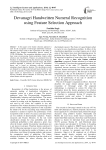
Devanagri Handwritten Numeral Recognition using Feature Selection Approach
Статья научная
In this paper novel feature selection approach is used for the recognition of Devanagri handwritten numerals. The numeral images used for the experiments in the study are obtained from standard benchmarking data-set created by CVPR (ISI)Kolkata. The recognition algorithm consists of four basic steps; pre-processing, feature generation, feature subset selection and classification. Features are generated from the boundary of characters, utilizing the direction based histogram of segmented compartment of the character image. The feature selection algorithm is utilizing the concept of information theory and is based on maximum relevance minimum redundancy based objective function. The classification results are obtained for a single neural network based classifier as well as for the committee of Neural Network based classifiers. The paper reports an improvement in recognition result when decision combiner based committee is used along with class related feature selection approach.
Бесплатно
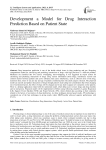
Development a Model for Drug Interaction Prediction Based on Patient State
Статья научная
Drug interactions prediction is one of the health critical issues in drug producing and use. Proposing computational model for classifying and predicting interactions of drugs with high precision is a difficult problem. Medicines are classified into two classes: overlapping, non-overlapping. It was suggested an expert system for classifying and predicting interactions of drugs using various information about drugs, interference reasons and common factors between patients and active substance that causes interference, such as: effective dose of the drug, maximum dose, times of use per day and age of patients considering that only adult category selected. The proposed model can classify and predict interactions of drugs through patient's state taking into consideration that when changing one of mentioned factors, the effect of drugs will be changed and it may lead to appear new symptoms on the patients. There is a desktop application related with the mentioned model, which helps users to know drugs and drugs families and its interactions. Proposed model will be implemented in Python using following classifiers: Logistic Regression (LR), Support Vector Machine (SVM) and Neural Network (NN), which divided data according to their similarity related to the factors of occurrence of drug interference. As these techniques showed good results, NN technology is considered one of the best techniques in giving results where MLPClassifier achieved superior performance with 97.12%.
Бесплатно

